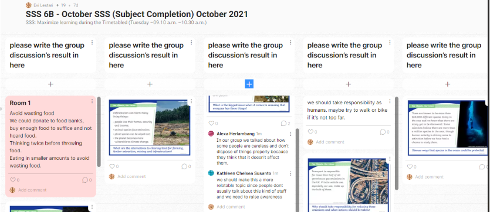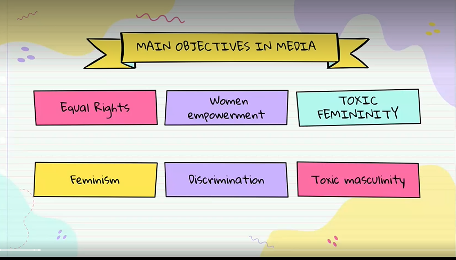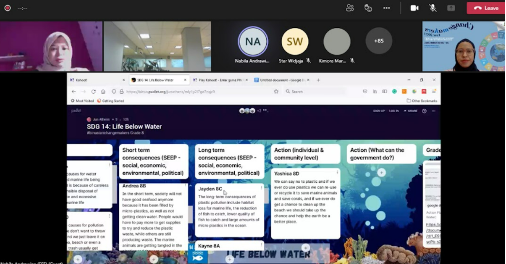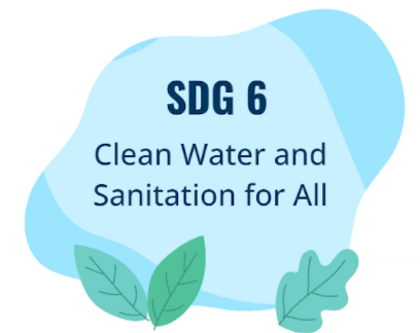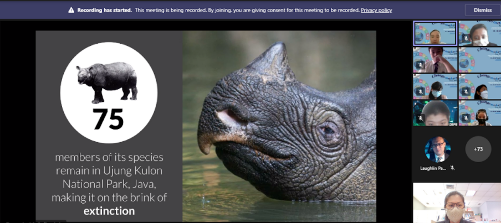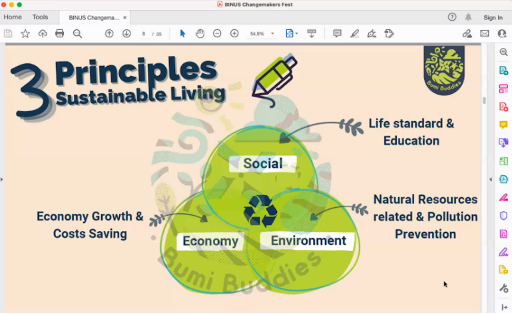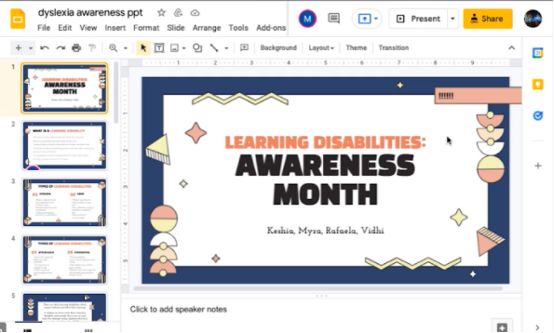Month: December 2021
Developing social and emotional skills
The adage, “Maslow before Bloom” reminds us, educators, of addressing students’ needs related to physiological, safety, belonging, esteem, and self-actualization before academics. If students’ fundamental needs are met first, it will have a positive impact on their learning.
Connected to addressing students’ well-being is the implementation of social and emotional learning (SEL), which promotes a safe, caring, and supportive environment. For our students to excel and be more ready, we have to equip them with social and emotional skills, not just literacy, numeracy, ICT or other academic skills.
Everyone, including parents, can work together to develop students’ social and emotional skills, which are the vital skills for success in school, work, and in life.
At BINUS SCHOOL Simprug, we teach our students the IB approaches to learning (ATLs), namely communication skills, research skills, self-management, social skills, and thinking skills, and the different sub-skills.
Social and emotional learning is connected to social skills and self-management skills. The benefits of social and emotional learning include the following:
- Addressing everyone’s well-being
- Ensuring that everyone is successful and feels valued
- Enhancing student learning
- Applying life skills
- Showing empathy, understanding, and appreciation to others
- Reducing stress, anxiety and depression
- Avoiding conflict with others
- Establishing positive relationships
- Promoting learner agency
Looking at the 2020 IB Programme standards and practices, developing SEL skills is related to the following IB requirements:
Student support 3: The school fosters the social, emotional, and physical well-being of its students and teachers. (0202-03)
Student support 3.1: The school identifies and allocates spaces and resources to support the social, emotional, and physical well-being of its students and teachers. (0202-03-0100)
Student support 3.2: The school demonstrates in its systems, processes and policies attention to the social, emotional, and physical well-being of its students and teachers. (0202-03-0200)
Student support 3.3: The pedagogical leadership team and teachers support students’ social, emotional and physical well-being. (0202-03-0300)
Student support 3.4: The school promotes open communication based on understanding and respect. (0202-03-0400)
One strategy that we can use to foster the social and emotional skills of our students is to make their own well-being visible. A person’s height is visible, but we cannot see an individual’s well-being, as it is inside the heart and mind.
Although well-being is an internal and invisible phenomenon, we can make it visible. We can find well-being clues based on what we see, hear, and feel. For example, we can ask our children to talk about or write what they see, hear, and feel when they are in class, at home, with their friends, or with their parents. Below is an example shared by one student.
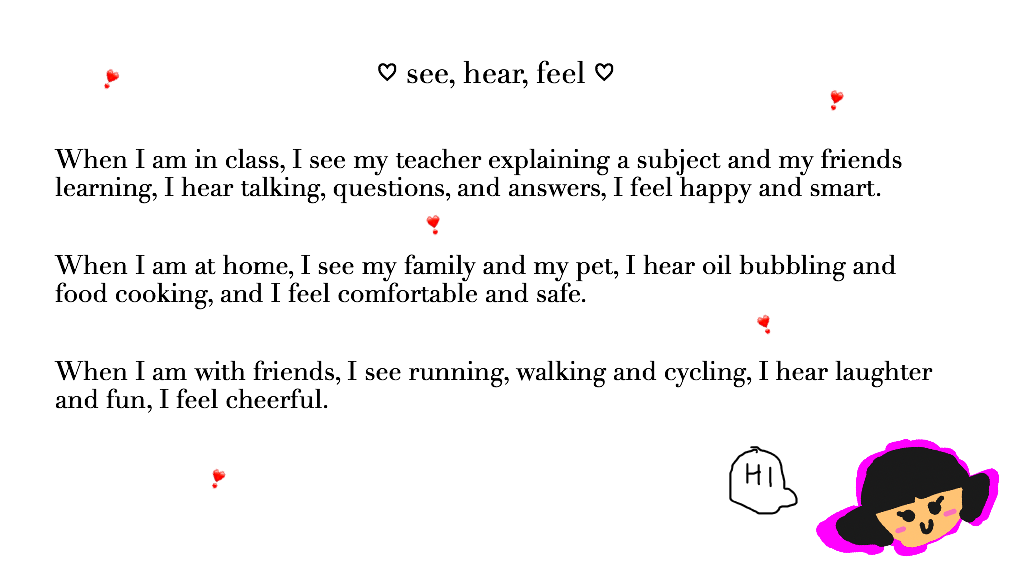
We can do the see-hear-feel technique with our children to make well-being visible. Interestingly, one student mentioned that when she is at home, she hears silence, as everyone in the family is busy doing their work.
Another strategy that we can use with our students is the five finger breathing exercise. We can use the index finger from the other hand to trace the hand slowly. As we trace up the tip of our finger, we inhale or breathe in. On the other hand, we exhale or breathe out as we trace down our finger.
When feeling anxious, upset, or offended, we can do deep breathing using the finger breathing technique. We can teach this simple exercise to our students. As shown below, it is a simple calming exercise using our fingers.
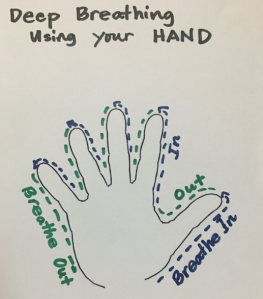
Managing or regulating emotions is important to students. In regulating emotions, students can be taught how to resolve problems. One approach involves asking the students to describe the problem, brainstorm solutions, choose the best solution, try the solution, and change the solution when needed.
Developing social and emotional skills of our students is a toolkit of practices. These practices include brain breaks activities using “Peace Out”, “Go Noodle”, and quick exercises by asking students to solve math equations.
Other practices by our colleagues on strengthening SEL skills include knowing and saying names of students, giving them a high-five or a hand-shake, using “Mood Meter”, and asking students to recognize, understand, label, express and regulate their emotions. During online learning, greeting students orally or in Microsoft Teams chat can substitute face-to-face greeting.
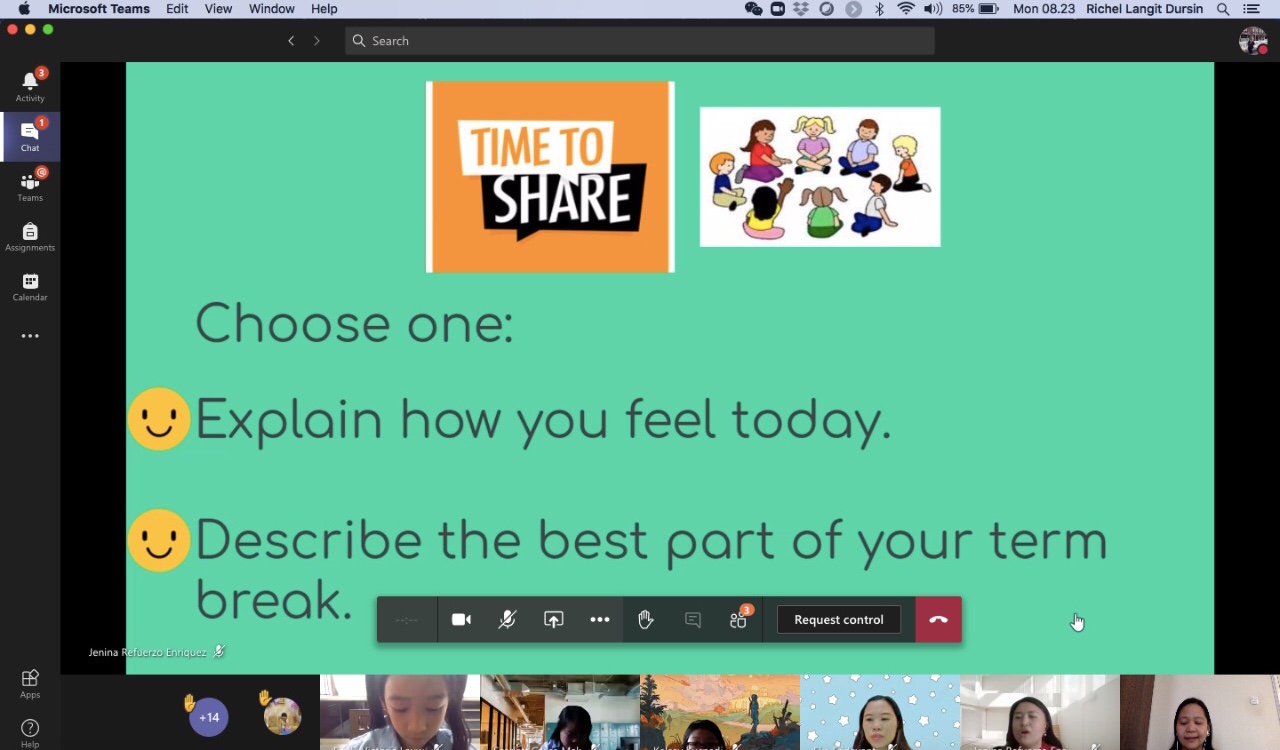
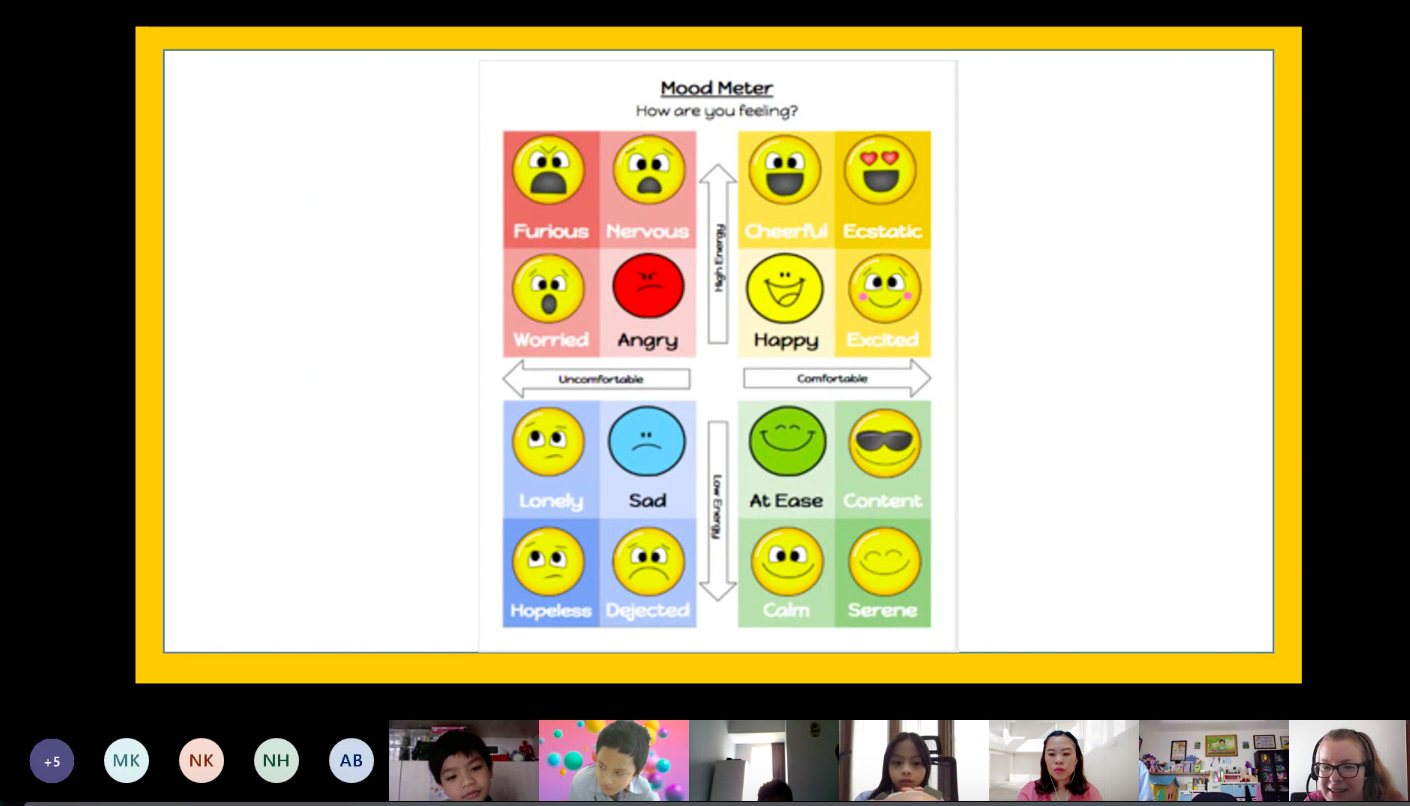
Linking the IB ATLs being focused on for each unit of inquiry with the Collaborative for Academic, Social, and Emotional Learning competencies can help teachers in the implementation of SEL. We can also consider collaboratively planning social and emotional learning engagements for the units of inquiry.
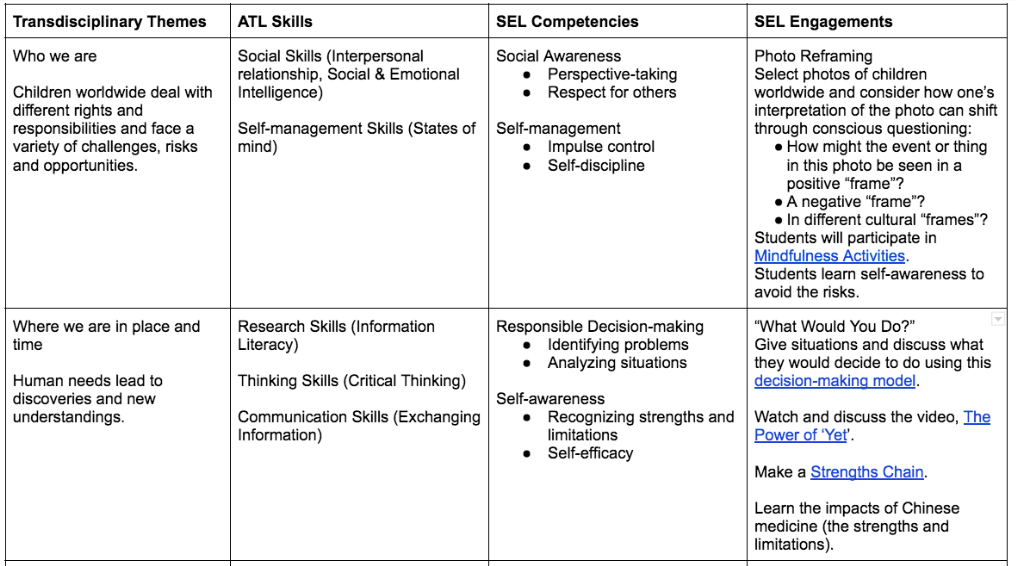
We all have an important role to play in developing social and emotional skills of students. Below is an illustration of what SEL implementation looks like, feels like, and sounds like at a school.

As human beings and educators, developing SEL skills has to be part of our “DNA”. For us to teach others, it has to start within ourselves. We need to model the SEL skills. Developing SEL skills can happen in all places and applies to us (teachers), our students, parents, and the rest of the school community.
Moreover, SEL development can be done all throughout the day and in every aspect of school culture, not just in the four walls of the classroom. Social and emotional learning does not have to be confined to a specific unit, time, or class. From the school lobby to the playground to the canteen to the hall, SEL is an essential part of our relationships and success.
By: Richel Langit-Dursin
EY-EL Vice Principal and PYP Coordinator
BINUS School Simprug
mdursin@binus.edu
Binusians as Changemakers
“More than ever before in human history, we share a common destiny. We can master it only if we face it together.” – Kofi Annan.
This quote by the former UN Secretary General also resonates with the mission of BINUS Schools – fostering and empowering society in building and serving the nation.
The Sustainable Development Goals (SDGs) or global goals have been the driving force in our school for the last few years. We have incorporated the 17 SDGs explicitly in our curriculum, linking all our units of inquiry and learning engagements within, to the achievement of these goals.
Over the years, several Binusians have demonstrated their commitment towards these global goals by working on various projects. Some of these projects have involved saving orangutans and rhinos, building schools and providing education in remote areas of Indonesia, working towards gender equality, etc.
This year, we decided to take a step further and have a celebration to salute these changemakers and to inspire others. We celebrated the SDGs through our ChangeMakers Fest which was from October 25 to October 28, 2021. This event was a whole-school collaboration, allowing around 1200 students from early years to grade 12 to collaborate and learn from each other.
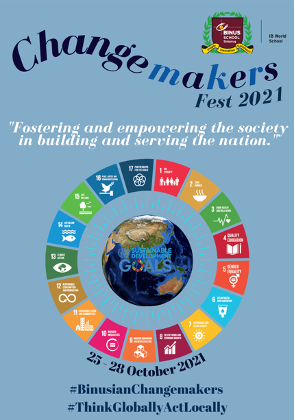
From October 25 to October 27, different grade levels focused on specific SDGs and planned activities to explicitly involve their students in those global goals. Some grade levels even collaborated which gave an opportunity to students of various age-levels to work together. Some of the activities that students participated in were compost making, growing plants at home, story reading, making better food choices, managing waste, using water wisely, to name a few.
Our big day was October 28, where around 1200 students along with their teachers gathered for the culminating event. Our day started with an inspirational opening by our school principal Mr. Peter M. Saidi. He and all members of the school executive committee have been the biggest supporters of this event. For this day, one SDG was assigned to each grade. These SDGs were assigned based on the current unit of inquiry or keen interest of that grade. After our principal’s opening address, all students joined their respective grade levels to attend guest sessions related to their assigned SDG.
Our student volunteers from Middle School and High School had been working tirelessly for the last several weeks to arrange the guest speakers, organising meetings with them and coordinating between these speakers and our school. Some of these speakers were our current and former students, who have worked on certain projects and used this event as a platform to share their work with fellow students. Others were experts in their respective fields. We had passionate speakers from Bumi Buddies, Going Green in Jakarta, Proyek Pencil, Bye Bye Plastic Bags BINUS Serpong, to name a few. These speakers gave our students an authentic learning experience from people who have made a difference.
This was the first time we had organized an event involving students across Primary Years Programme, Middle Years Programme, and Diploma Programme. There were things which could have been better and online learning provided its own challenges. However, this event gave a platform to our students and teachers to collaborate beyond the needs of the curriculum, to think about issues arising in our immediate surroundings and the rest of the world and to think about ways of individual/group effective action. As Mahatma Gandhi had once said, ‘Be the change you wish to see in the world’. We need to initiate change in our world to see any real difference. And our classrooms/schools are a good place to start.

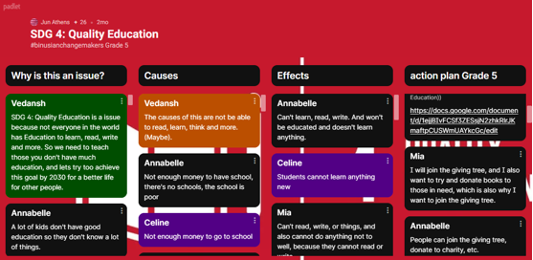
By: Priyanka Patni
Grade 4 Level Head
BINUS SCHOOL Simprug
ppatni@binus.edu


